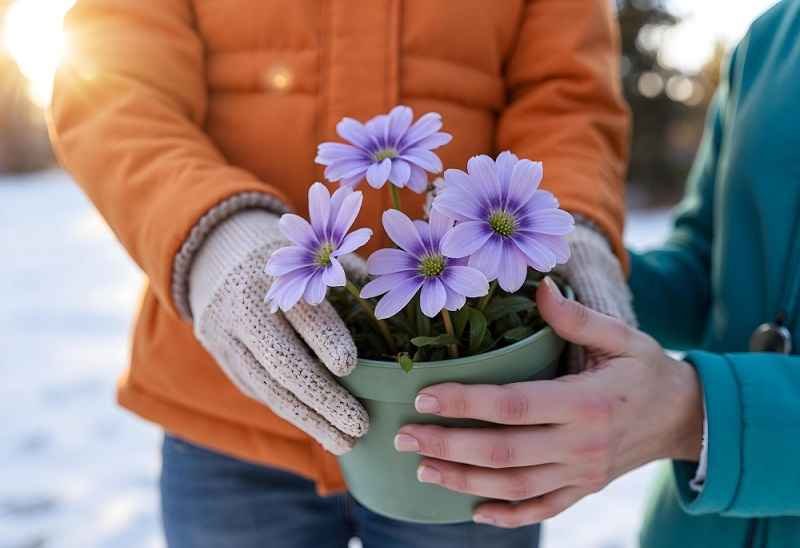Introduction: How to Protect Plants from Frost
Frost can be a gardener’s worst enemy, especially during early spring or late fall when unexpected cold snaps occur. Frost forms when temperatures drop below freezing, causing moisture in the air to condense and freeze on plant surfaces. While some plants can tolerate frost, many are susceptible to damage, including wilting, discoloration, and even death.
Understanding how to protect your plants from frost is essential to maintaining a thriving garden year-round. In this guide, we’ll explore effective methods to safeguard your plants from frost damage and ensure they remain healthy through chilly weather.
How Frost Affects Plants
Frost affects plants by freezing the water inside their cells. When the water freezes, it expands, rupturing the cell walls. This damage often results in wilted or blackened leaves, stunted growth, and in severe cases, the death of the plant. Frost is especially harmful to tender plants, seedlings, and tropical species that are not adapted to cold climates.
Common signs of frost damage include:
- Blackened or mushy leaves
- Wilted stems and foliage
- Slow or halted growth
- Scarring or splitting of fruits
By taking proactive measures to protect your plants, you can minimize frost damage and keep your garden thriving.
Top Techniques to Protect Plants from Frost
Here are some of the most effective ways to shield your plants from frost:
1. Cover Your Plants
One of the simplest and most effective ways to protect plants from frost is by covering them. This creates a barrier that traps heat and prevents frost from settling on the plant’s surface.
- What to Use: Old bedsheets, blankets, burlap, or frost cloths work well. Avoid using plastic directly on plants, as it can trap moisture and cause freeze burn.
- How to Cover: Drape the material loosely over the plants, ensuring it reaches the ground to trap heat. Use stakes or supports to prevent the cover from touching the foliage, which can transfer cold directly to the plant.
- When to Remove: Remove the cover during the day when temperatures rise to allow sunlight to reach the plants.
2. Water Your Plants Before Frost
It might seem counterintuitive, but watering your plants before a frost can help protect them. Moist soil retains heat better than dry soil, which helps keep the air around the plants slightly warmer.
- Timing: Water the soil in the late afternoon before a frost is expected. Avoid overwatering, as soggy soil can lead to root rot.
3. Add Mulch Around Plants
Mulch acts as an insulating layer that helps regulate soil temperature and retain heat. It’s particularly effective for protecting root systems.
- Materials to Use: Straw, wood chips, leaves, or compost.
- Application: Spread a 2-3 inch layer of mulch around the base of your plants, being careful not to pile it directly against the stems.
4. Move Potted Plants Indoors
Potted plants are especially vulnerable to frost because their roots are more exposed to cold temperatures.
- What to Do: Move potted plants indoors, into a greenhouse, or to a sheltered area like a garage or covered patio.
- Positioning: Place them near a sunny window or use grow lights to ensure they receive enough light while indoors.
5. Use Frost Covers or Cloches
Frost covers and cloches are specialized tools designed to protect plants from cold weather.
- Frost Covers: Lightweight, breathable fabrics that trap heat while allowing moisture to escape.
- Cloches: Bell-shaped covers made of glass or plastic that protect individual plants. Simply place them over vulnerable plants before nightfall.
6. Create a Heat Source
Supplementing heat can make a big difference in protecting plants from frost.
- Options: Use outdoor-safe heat lamps, string lights (non-LED), or place buckets of warm water near your plants to radiate heat overnight.
- Safety First: Always ensure that heat sources are safe to use outdoors and are not a fire hazard.
7. Build a Windbreak
Cold winds can intensify frost damage by stripping away any warmth around your plants.
- How to Build: Use barriers like fences, hedges, or temporary panels made of cardboard or burlap to shield plants from cold winds.
8. Harvest Vulnerable Crops Early
For fruits and vegetables that are close to ripening, consider harvesting them before a frost hits. Crops like tomatoes, peppers, and squash can be picked early and ripened indoors.
Long-Term Strategies for Frost Protection
In addition to short-term solutions, implementing long-term strategies can help your garden withstand frost:
1. Choose Frost-Resistant Plants
Opt for plants that are naturally frost-hardy, such as kale, pansies, and snapdragons. These plants can tolerate cold temperatures and are less likely to suffer frost damage.
2. Plant in Frost-Safe Locations
- Higher Ground: Cold air tends to settle in low-lying areas, so plant frost-sensitive plants on higher ground.
- South-Facing Walls: Planting near south-facing walls or structures provides additional warmth and protection from cold winds.
3. Invest in a Greenhouse
Greenhouses provide a controlled environment that protects plants from frost and other extreme weather conditions. They’re a great option for serious gardeners or those with tropical plants.
4. Use Raised Beds
Raised beds warm up faster than ground soil, providing better protection for plant roots during frost.
What to Do If Your Plants Are Damaged by Frost
If frost damage does occur, don’t panic. Many plants are resilient and can recover with proper care:
- Wait Before Pruning: Resist the urge to prune damaged plants immediately. Wait until the weather warms up and new growth appears to determine which parts of the plant are still viable.
- Water and Mulch: Keep the soil moist and add mulch to help the plant recover.
- Provide Warmth: If another frost is expected, take extra measures to protect the plant while it heals.
Conclusion
Frost doesn’t have to spell disaster for your garden. With the right preparation and strategies, you can protect your plants from freezing temperatures and ensure they remain healthy and vibrant. From simple solutions like covering plants and adding mulch to long-term investments like greenhouses, there are plenty of ways to safeguard your garden.
By staying proactive and attentive to weather conditions, you can enjoy a thriving garden even during the coldest months. Protect your plants from frost, and they’ll reward you with beauty and abundance year-round.
Keep your garden safe and thriving—learn how to protect plants from frost with these practical, effective tips.
For more, visit our website, Homethreads







